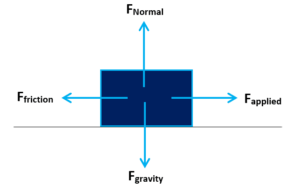To solve the problem of finding the final velocities of both blocks after an elastic collision, we need to use both the conservation of momentum and conservation of kinetic energy principles. The masses and initial velocities will be plugged into these equations to determine the final velocities.
Let:
– m_1 = 1.5 \, \text{kg} (mass of Block 1)
– m_2 = 0.75 \, \text{kg} (mass of Block 2)
– u_1 = 3 \, \text{m/s} (initial velocity of Block 1)
– u_2 = 0 \, \text{m/s} (initial velocity of Block 2, as it is at rest)
– v_1 (final velocity of Block 1)
– v_2 (final velocity of Block 2)
| Step | Derivation/Formula | Reasoning |
|---|---|---|
| 1 | m_1 u_1 + m_2 u_2 = m_1 v_1 + m_2 v_2 | Conservation of momentum equation. In elastic collisions, momentum is conserved before and after the collision. |
| 2 | 1.5 \times 3 + 0.75 \times 0 = 1.5 v_1 + 0.75 v_2 4.5 = 1.5 v_1 + 0.75 v_2 |
Substitute known values |
| 3 | \frac{1}{2} m_1 u_1^2 + \frac{1}{2} m_2 u_2^2 = \frac{1}{2} m_1 v_1^2 + \frac{1}{2} m_2 v_2^2 | Conservation of kinetic energy equation, also conserved in elastic collisions. |
| 4 | \frac{1}{2} \times 1.5 \times 3^2 + \frac{1}{2} \times 0.75 \times 0^2 = \frac{1}{2} \times 1.5 \times v_1^2 + \frac{1}{2} \times 0.75 \times v_2^2 6.75 = 0.75 v_1^2 + 0.375 v_2^2 |
Substitute known values |
| 5 | Solve two equations (from previous steps) simultaneously:
Equation 1: 4.5 = 1.5 v_1 + 0.75 v_2 Equation 2: 6.75 = 0.75 v_1^2 + 0.375 v_2^2 |
Use algebraic methods (substitution, elimination) to solve for v_1 and v_2 from equations from step 2 and step 4. |
| 6 | After solving: v_1 = 1 \, \text{m/s} v_2 = 4 \, \text{m/s} |
Final solution |
This solution strategy provides the final velocities of each block after the collision, assuming perfectly elastic conditions where both momentum and kinetic energy are conserved.
Phy can also check your working. Just snap a picture!

The box in the diagram is sliding to the right across a horizontal table, under the influence of the forces shown. Which force(s) is doing negative work on the box?
A rubber ball and a lump of clay have equal mass. They are thrown with equal speed against a wall. The ball bounces back with nearly the same speed with which it hit. The clay sticks to the wall. Which one of these objects experiences the greater impulse?
A spring launches a 4 kg block across a frictionless horizontal surface. The block then ascends a 30° incline with a kinetic friction coefficient of 0.25, stopping after 55 m on the incline. If the spring constant is 800 N/m, find the initial compression of the spring. Disregard friction while in contact with the spring.
A uniform solid cylinder of mass M and radius R is initially at rest on a frictionless horizontal surface. A massless string is attached to the cylinder and is wrapped around it. The string is then pulled with a constant force F , causing the cylinder to rotate about its center of mass. After the cylinder has rotated through an angle \theta , what is the kinetic energy of the cylinder in terms of F and \theta ?
A 0.50-kg mass is attached to a spring constant 20 N/m along a horizontal, frictionless surface. The object oscillates in simple harmonic motion and has a speed of 1.5 m/s at the equilibrium position. What is the total energy of the system?
Block 1 (1.5 kg): 1.0 m/s to the right
Block 2 (0.75 kg): 4.0 m/s to the right
By continuing you (1) agree to our Terms of Sale and Terms of Use and (2) consent to sharing your IP and browser information used by this site’s security protocols as outlined in our Privacy Policy.
| Kinematics | Forces |
|---|---|
| \Delta x = v_i t + \frac{1}{2} at^2 | F = ma |
| v = v_i + at | F_g = \frac{G m_1m_2}{r^2} |
| a = \frac{\Delta v}{\Delta t} | f = \mu N |
| R = \frac{v_i^2 \sin(2\theta)}{g} |
| Circular Motion | Energy |
|---|---|
| F_c = \frac{mv^2}{r} | KE = \frac{1}{2} mv^2 |
| a_c = \frac{v^2}{r} | PE = mgh |
| KE_i + PE_i = KE_f + PE_f |
| Momentum | Torque and Rotations |
|---|---|
| p = m v | \tau = r \cdot F \cdot \sin(\theta) |
| J = \Delta p | I = \sum mr^2 |
| p_i = p_f | L = I \cdot \omega |
| Simple Harmonic Motion |
|---|
| F = -k x |
| T = 2\pi \sqrt{\frac{l}{g}} |
| T = 2\pi \sqrt{\frac{m}{k}} |
| Constant | Description |
|---|---|
| g | Acceleration due to gravity, typically 9.8 , \text{m/s}^2 on Earth’s surface |
| G | Universal Gravitational Constant, 6.674 \times 10^{-11} , \text{N} \cdot \text{m}^2/\text{kg}^2 |
| \mu_k and \mu_s | Coefficients of kinetic (\mu_k) and static (\mu_s) friction, dimensionless. Static friction (\mu_s) is usually greater than kinetic friction (\mu_k) as it resists the start of motion. |
| k | Spring constant, in \text{N/m} |
| M_E = 5.972 \times 10^{24} , \text{kg} | Mass of the Earth |
| M_M = 7.348 \times 10^{22} , \text{kg} | Mass of the Moon |
| M_M = 1.989 \times 10^{30} , \text{kg} | Mass of the Sun |
| Variable | SI Unit |
|---|---|
| s (Displacement) | \text{meters (m)} |
| v (Velocity) | \text{meters per second (m/s)} |
| a (Acceleration) | \text{meters per second squared (m/s}^2\text{)} |
| t (Time) | \text{seconds (s)} |
| m (Mass) | \text{kilograms (kg)} |
| Variable | Derived SI Unit |
|---|---|
| F (Force) | \text{newtons (N)} |
| E, PE, KE (Energy, Potential Energy, Kinetic Energy) | \text{joules (J)} |
| P (Power) | \text{watts (W)} |
| p (Momentum) | \text{kilogram meters per second (kgm/s)} |
| \omega (Angular Velocity) | \text{radians per second (rad/s)} |
| \tau (Torque) | \text{newton meters (Nm)} |
| I (Moment of Inertia) | \text{kilogram meter squared (kgm}^2\text{)} |
| f (Frequency) | \text{hertz (Hz)} |
General Metric Conversion Chart
Example of using unit analysis: Convert 5 kilometers to millimeters.
Start with the given measurement: \text{5 km}
Use the conversion factors for kilometers to meters and meters to millimeters: \text{5 km} \times \frac{10^3 \, \text{m}}{1 \, \text{km}} \times \frac{10^3 \, \text{mm}}{1 \, \text{m}}
Perform the multiplication: \text{5 km} \times \frac{10^3 \, \text{m}}{1 \, \text{km}} \times \frac{10^3 \, \text{mm}}{1 \, \text{m}} = 5 \times 10^3 \times 10^3 \, \text{mm}
Simplify to get the final answer: \boxed{5 \times 10^6 \, \text{mm}}
Prefix | Symbol | Power of Ten | Equivalent |
|---|---|---|---|
Pico- | p | 10^{-12} | 0.000000000001 |
Nano- | n | 10^{-9} | 0.000000001 |
Micro- | µ | 10^{-6} | 0.000001 |
Milli- | m | 10^{-3} | 0.001 |
Centi- | c | 10^{-2} | 0.01 |
Deci- | d | 10^{-1} | 0.1 |
(Base unit) | – | 10^{0} | 1 |
Deca- or Deka- | da | 10^{1} | 10 |
Hecto- | h | 10^{2} | 100 |
Kilo- | k | 10^{3} | 1,000 |
Mega- | M | 10^{6} | 1,000,000 |
Giga- | G | 10^{9} | 1,000,000,000 |
Tera- | T | 10^{12} | 1,000,000,000,000 |
The most advanced version of Phy. Currently 50% off, for early supporters.
per month
Billed Monthly. Cancel Anytime.
Trial –> Phy Pro
A quick explanation
UBQ credits are specifically used to grade your FRQs and GQs.
You can still view questions and see answers without credits.
Submitting an answer counts as 1 attempt.
Seeing answer or explanation counts as a failed attempt.
Lastly, check your average score, across every attempt, in the top left.
MCQs are 1 point each. GQs are 1 point. FRQs will state points for each part.
Phy can give partial credit for GQs & FRQs.
Phy sees everything.
It customizes responses, explanations, and feedback based on what you struggle with. Try your best on every question!
Understand you mistakes quicker.

For GQs and FRQs, Phy provides brief feedback as to how you can improve your answer.
Aim to increase your understadning and average score with every attempt!
10 Free Credits To Get You Started
*Phy Pro members get unlimited credits

By continuing you agree to nerd-notes.com Terms of Service, Privacy Policy, and our usage of user data.